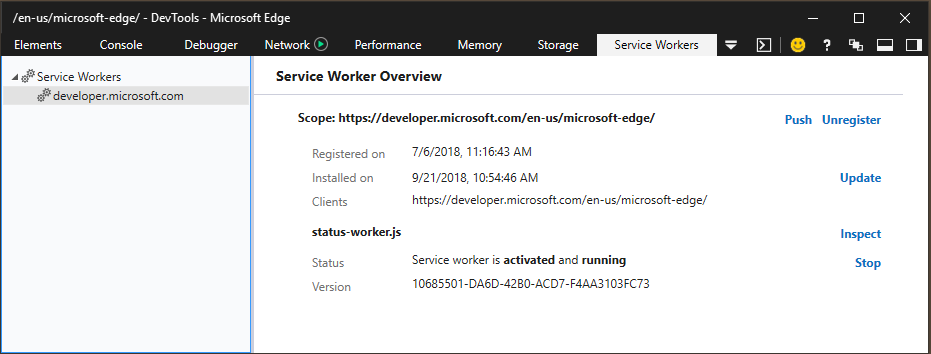Service Workers
The Service Workers panel has tools for managing and debugging the service workers for your site, to help you:
- Get an overview of all the service workers associated with your site and details of their scope and status
- Update and manage (Unregister) the service worker registration for the given scope
- Push a test notification
- Stop/Start individual service workers, and
- Inspect the selected service worker in a separate debugger window

Please note the following about service worker debugging in Edge DevTools:
Debugging a service worker will launch a new instance of the DevTools separate from the page's tools because service workers can be shared across multiple tabs.
The Elements and Emulation panels are absent from the service worker debugger, given that service workers run in the background and do not directly control the front-end of your app.
Currently network traffic for a service worker is only reported from the DevTools debugging instance for that worker, and not from the debugger instance for the page itself.
To simulate a Push from the DevTools, you'll need to add a push event listener to your service worker in order to observe its effect. The following example will print "Test push message from DevTools" in your service worker Console.
self.addEventListener('push', function(event){ console.log(event.data.text()); });
Here are some general things to keep in mind when using service workers:
HTTPS-only. Service workers will not work in HTTP; you will need to use HTTPS. However, you can register service workers on
localhostfor testing purposes.No DOM access allowed. As with web workers, you don't get access to the page's object model. This means that if you need to change something about the page, you'll need to use
postMessagefrom the service worker to the page so that you can handle it DOM changes from the page.Executes separate from page. Because these scripts are not tied to the lifetime of a page, it's important to understand that they do not share the same context as the page. Aside from not having access to the DOM (as stated earlier), they won't have access to the same variables available on the page.
Overrides App Cache. App Cache will be ignored when service workers are in use. The Service Worker API is intended to entirely supplant App Cache by giving more granular control to the web developer.
- Script can't be on CDN. The JavaScript file for the service worker can't be hosted on a Content Distribution Network (CDN), it must be on the same domain as the page. However, if you like, you can import scripts from your CDN.
Can be terminated any time. Service workers are meant to be short-lived and their lifetime is tied to events. In particular, service workers have a time limit in which they must finish executing their event handlers. In other cases, the browser or the operating system may choose to terminate a service worker that impacts the battery, CPU, or memory consumption. In either case, avoid relying on global variables in the service worker script in case a different service worker instance is used on a subsequent event that's being handled.
Only asynchronous requests allowed. Synchronous XHR is not allowed here! Neither is localStorage, so it's best to make use of IndexedDB and the new Caches API described earlier.
Service worker to scope is 1:1. You'll only be able to have one service worker per scope. That means if you try to register a different service worker for a scope that already has a service worker, that service worker will be updated.